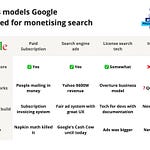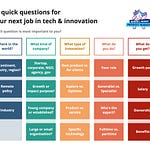💡 I went through 20+ blog posts, books, articles, and chapters on beachhead markets. Most of them repeat the same chunks without actionable insights. Therefore, I’m writing a series on beachhead markets.
Beachhead market series
📰 What makes a great beachhead market?
➡️ Today: Five expansion strategies from your beachhead market
🗓️ Planned: Getting traction in your beachhead market
🗓️ Planned: Performance-based beachhead: lessons from the steam engine
Having a beachhead in your to-market strategy increases the likelihood of startup success. In the previous edition, I explained what makes a good beachhead market. If you missed that, click here.
Five beachhead expansion strategies
Note: I use beachhead quite freely. Sometimes the companies already had a good grip on a market and fortified that grip with an expansive strategy. Still, I believe these can serve as inspiration to improve your fit with the market.
🙋 Need-product-based expansion
Strategy: Starting from a captured niche, identify adjacent market needs and developing products and features for that.
Physical products are hard to ‘update’
UnderArmour started with undershirts but expanded to many types of sports clothing.
Likewise, TropicFeel started with a single travel shoe on Kickstarter and now has a range of travel gear including many shoe models, backpacks and pants.
Tesla started with a premium roadster car and now offers a mid-market car.
Build a product portfolio to serve a variety of segments. This can work for digital products too.
Digital product portfolio can serve different segments
Adobe started with PostScript and sold a license to Apple, making it the first company in the Valley to become profitable in the first year. It was software that allowed for consistent printing. From this, it developed into the company we knew, launching Illustrator and Photoshop, which both serve different needs, that later developed in the Creative Cloud.
You can add features to digital products to improve the product-market fit
Slack started as a spun-out chat app of a failed gaming company. Their game failed but their internally developed communication tool had potential. The first version had limited adoption.
They had beta customers like Rdio and Medium. From this, they quickly learned that they needed to build for larger teams (10+) and larger organisations. Instead of highlighting 1 specific feature, such as their integrations via chatbots, a constant improvement of the product increased its product-market fit.
It’s hard to draw the line with digital products, where the difference between the Tesla Roadster and the Tesla Model 3 is very clear. Figma highlights Team Libraries as a key accelerator to the mainstream market. Digital products are more easily expandable than physical products in the sense that you can add features.
Expand by identifying relevant adjacent customer needs
What are logical companion products to your product?
What is the competition that you can copy and offer as a suite?
Watch out for Swiss army knives or feature creep though.
The fact that Elon had that strategy upfront doesn’t mean you need one from day one. Assume you are not Elon. But keep a vigilant eye out there for things you could offer in the future.
↕️ Vertical-based expansion
Strategy: Start with a niche, identify verticals for which you don’t need to adjust your product/service heavily and add those categories.
In some cases, especially platforms, you can choose a vertical approach. Amazon started with books and now is serving almost everything. Strava started with Running & Cycling, but now you can upload almost any activity.
Strava advertises itself as hiking right now, where there’s fierce competition from AllTrails or Komoot who have a very dominant focus on hiking and other mountainy sports. Bumble expanded from dating into Friends & Business, however I’m not sure about the traction there.
Expand by identifying relevant verticals
As a bootstrap fanatic, I always like niche vertical approaches.
I see many startups that want to be the platform/app for all verticals, but seldom that’s an easy starting point. For instance, if your CAC is high and you need to serve 10 verticals at once, you need capital. Dominating one vertical is tricky enough.
Vertical expansion strategies allow you to quickly enter new markets because your product doesn’t require much alteration. A book listing on Amazon or a DVD listing on Amazon is not all that different.
Vertical strategy can also be a strategy to disrupt an incumbent. Whoppah is a Dutch Craigslist focusing solely on (premium) design furniture.
Launching Uber Eats next to the Uber cab service is quite different. Make an estimate of the resources you need for the execution of a vertical, it’s always higher than you expect.
Do experiments if you can generate demand for that vertical, start with existing channels you already know for rapid experimentation.
↔️ Value chain expansion
Strategy: Start with a tiny segment of the value chain you can directly offer value. Leverage that position to expand either upstream or downstream.
Note: upstream means closer to the source, and downstream means closer to the application. Apple starting to produce their own processors is moving upstream. If Apple would offer in-home installation, that is moving downstream.
This one is harder to find, as up or down the value chain different skills become relevant. As a startup, you first become good at doing 1 thing really well, and that is hard enough.
It’s closer to home for Strava to add the hiking vertical rather than to add a run coaching-matching platform. They did add route planning though, moving up the customer journey, however, I wouldn’t say that is a mainstream unlocking move.
From advice to end-to-end services
Home battery company AccuSelect wanted to enable homeowners to get home batteries. Home batteries are capital-intensive. They didn’t have those resources at the start. Therefore, they started out by selling advice on which home battery to select.
Next, they added installer matching. Now that they have got some validation on that initial proposition, they are going to buy and sell home batteries with their own partnered installers that wear their t-shirts. Customers didn’t care about which battery, they just wanted a good one. Going upstream for selling batteries and downstream for offering the service.
In-housing delivery for better market fit
Coolblue (e-commerce for consumer electronics) at some point in-housed delivery of washing machines. They offered end-to-end service with installation and taking away your old washing machine. With that, they offer a great service.
Thuisbezorgd, a Dutch UberEats competitor, started a decade before UberEats entered the Dutch market. Thuisbezorgd first was an order-only platform and they relied on the delivery staff of the restaurants (quite some venues had that).
However, with Uber Eats on the block, Thuisbezorgd added delivery services with their own fleet of drivers, moving down the value chain.
Expand by moving up or down the value stream
Expanding up or down the value stream can be costly because usually, it requires an entirely different type of organisation. Delivery fleets are other than just digital orders and payment services.
Because of this, not many startups want to overthrow the organisation they are building. This might be the reason I couldn’t find many examples here. Be wary!
📍 Location based
Strategy: Start with a niche region, such as 1 city, and later expand to different cities, one by one.
Uber started in San Fransisco to later expanded to other cities and countries. The dating app Breeze started in the Rotterdam Area to later expanded to other cities. For both Breeze and Uber, the needs per customer were quite similar between cities and for Uber between countries (except for countries with low credit card adoption). This doesn’t mean they didn’t need to build a killer product.
Location-based segmentation works particularly well for online and local (duh) services. Focusing on a location allows you to focus your marketing efforts. Especially for (two-sided) platforms, where supply and demand should match, this is a clever way to define the beachhead market to see if you can generate value. People in Amsterdam don’t care about a cab service in Paris.
Expand by shifting marketing efforts
If a location-based beachhead is logical for your startup, you can shift your marketing efforts to grow.
With aimed targeting via i.e. Instagram or Facebook or aiming your cold outreach calls to a specific region.
👨👨👧👦 Demographic-based
Strategy: Target a niche segment based on demographics to get traction within one community. Expand by shifting marketing efforts to other demographics.
Sometimes, one can target an entire country but focus on a specific demographic. Facebook and Tinder started on college campuses attracting students. Tinder went by frat & sorority houses cause (people get laid there?) manually to get students to sign up. Obviously, this is location-based too.
Expand by shifting marketing efforts
If your product serves a more general crowd, you can start a niche and shift marketing efforts to different demographics.
Especially with targeting options on Instagram and Facebook, you can more specifically aim your offering to a different population.
The best markets are those you can sell in
You don’t decide what works
You can’t just pick and choose any one of the above strategies. It’s like wands in Harry Potter, the market will let you know whether you can successfully deploy such a strategy.
Therefore, doing experiments on a variety of subsequent segments could be a wise move before going all in. Do 10x10 calls if you are B2B, not everything needs to be a smokescreen.
Your choice is limited, don’t overstretch yourself.
Your initial value proposition and segment limit the options. You can’t expand into any market because you like the market.
Strava could’ve expanded in many directions, on paper, but choose to stay close to home. There aren’t many examples of companies, besides Yahama, making pianos and Motorcycles, that serve widely different customer segments
You are not married to your beachhead market
Tesla did actually drop his initial market segment. They stopped building the Roadster in 2012.
Tesla is set to release a new Tesla Roadster (2nd Gen) this year. Sometimes, your launching customers can be an anchor, holding you back. See if you are holding on to your beachhead too long.
You can combine
Sometimes, a location-based, demographics based and need-based approach is combined. You don’t immediately sell to everyone in your entire country.
You target HR recruiters in the Amsterdam Area aged 30-45 because they have enough managerial experience to recognise the problem, are open enough to new things on average based on your interviews, and want to have a face-to-face meeting so that the region allows you to do the calls. Whatever works.
Did you like this article on beachhead expansion strategies?
Well, it was Great - Good - Meh
Need help expanding from your beachhead?
I will help you to identify expansion strategies and develop tactics to get there. Read some of my reviews and my way of working below.
I’ve got one spot left for the coming months. Ooooh, that urgency. Do you feel it?




















Share this post